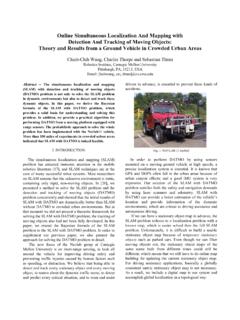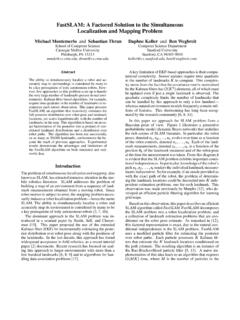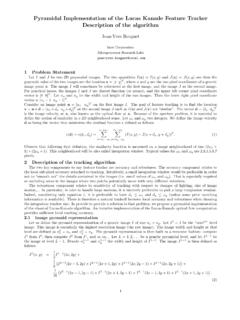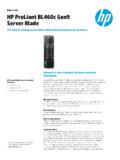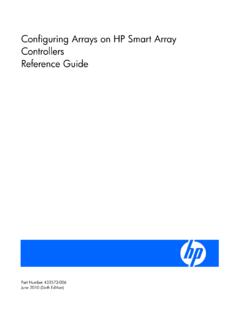Transcription of Stanley: The robot that won the DARPA Grand Challenge
1 stanley : The robot that Wonthe DARPA Grand ChallengeSebastian Thrun, Mike Montemerlo,Hendrik Dahlkamp, David Stavens,Andrei Aron, James Diebel, Philip Fong,John Gale, Morgan Halpenny,Gabriel Hoffmann, Kenny Lau, Celia Oakley,Mark Palatucci, Vaughan Pratt,and Pascal StangStanford Artificial Intelligence LaboratoryStanford UniversityStanford, California 94305 Sven Strohband, Cedric Dupont,Lars-Erik Jendrossek, Christian Koelen,Charles Markey, Carlo Rummel,Joe van Niekerk, Eric Jensen,and Philippe AlessandriniVolkswagen of America, Research Laboratory4009 Miranda Avenue, Suite 100 Palo Alto, California 94304 Gary Bradski, Bob Davies, Scott Ettinger,Adrian Kaehler, and Ara NefianIntel Research2200 Mission College BoulevardSanta Clara, California 95052 Pamela MahoneyMohr Davidow Ventures3000 Sand Hill Road, Bldg.
2 3, Suite 290 Menlo Park, California 94025 Received 13 April 2006; accepted 27 June 2006 Journal of Field Robotics 23(9), 661 692 (2006) 2006 Wiley Periodicals, online in Wiley InterScience ( ). DOI: article describes the robot stanley , which won the 2005 DARPA Grand was developed for high-speed desert driving without manual intervention. Therobot s software system relied predominately on state-of-the-art artificial intelligencetechnologies, such as machine learning and probabilistic reasoning. This paper describesthe major components of this architecture, and discusses the results of the Grand Chal-lenge race. 2006 Wiley Periodicals, INTRODUCTIONThe Grand Challenge was launched by the DefenseAdvanced Research Projects Agency DARPA in2003 to spur innovation in unmanned ground vehiclenavigation.
3 The goal of the Challenge was to developan autonomous robot capable of traversing unre-hearsed off-road terrain. The first competition, whichcarried a prize of $1M, took place on March 13, required robots to navigate a 142-mile long coursethrough the Mojave desert in no more than 10 h. 107teams registered and 15 raced, yet none of the par-ticipating robots navigated more than 5% of the entirecourse. The Challenge was repeated on October 8,2005, with an increased prize of $2M. This time, 195teams registered and 23 raced. Of those, five teamsfinished. Stanford s robot stanley finished thecourse ahead of all other vehicles in 6 h, 53 min, and58 s, and was declared the winner of the DARPAG rand Challenge ; see Figure paper describes the robot stanley , and itssoftware system in particular.
4 stanley was developedby a team of researchers to advance the state-of-the-art in autonomous driving. stanley s success is the re-sult of an intense development effort led by StanfordUniversity, and involving experts from Volkswagenof America, Mohr Davidow Ventures, Intel Research,and a number of other entities. stanley is based on a2004 Volkswagen Touareg R5 TDI, outfitted with a sixprocessor computing platform provided by Intel, anda suite of sensors and actuators for autonomous driv-ing. Figure 2 shows images of stanley during the main technological Challenge in the develop-ment of stanley was to build a highly reliable system,capable of driving at relatively high speeds throughdiverse and unstructured off-road environments, andto do all this with high precision.
5 These requirementsled to a number of advances in the field of autono-mous navigation, as surveyed in this paper. Methodswere developed, and existing methods extended, inthe areas of long-range terrain perception, real-timecollision avoidance, and stable vehicle control on slip-pery and rugged terrain. Many of these develop-ments were driven by the speed requirement, whichrendered many classical techniques in the off-roaddriving field unsuitable. In pursuing these develop-ments, the research team brought to bear algorithmsFigure 1. a At approximately 1:40 pm on Oct 8, 2005, stanley was the first robot to complete the DARPA GrandChallenge. b The robot is being honored by DARPA Director Dr.
6 Tony Journal of Field Robotics 2006 Journal of Field RoboticsDOI diverse areas including distributed systems,machine learning, and probabilistic Race RulesThe rules DARPA , 2004 of the DARPA Grand Chal-lenge were simple. Contestants were required tobuild autonomous ground vehicles capable of tra-versing a desert course up to 175-miles long in lessthan 10 h. Thefirst robot to complete the course inunder 10 h would win the Challenge and the $2 Mprize. Absolutely no manual intervention was al-lowed. The robots were started by DARPA personneland from that point on had to drive only saw their robots at the starting line and,with luck, at thefinish the 2004 and 2005 races were held in theMojave desert in the southwest United States.
7 Thecourse terrain varied from high-quality graded dirtroads to winding rocky mountain passes; see Figure2. A small fraction of each course traveled alongpaved roads. The 2004 course started in Barstow,CA, approximately 100 miles northeast of Los Ange-les, andfinished in Primm, NV, approximately30 miles southwest of Las Vegas. The 2005 courseboth started andfinished in Primm, specific race course was kept secret from allteams until 2 h before the race. At this time, eachteam was given a description of the course on CD-ROM in a DARPA -defined route definition data for-mat RDDF . The RDDF is a list of longitudes, lati-tudes, and corridor widths that define the courseboundary, and a list of associated speed limits; anexample segment is shown in Figure 3.
8 Robots thattravel substantially beyond the course boundary riskdisqualification. In the 2005 race, the RDDF con-tained 2,935 width of the race corridor generally trackedthe width of the road, varying between 3 and 30 min the 2005 race. Speed limits were used to protectimportant infrastructure and ecology along thecourse, and to maintain the safety of DARPA chasedrivers who followed behind each robot . The speedlimits varied between 5 and 50 mph. The RDDF de-fined the approximate route that robots would take,Figure from the section of the RDDF file from the 2005 DARPA Grand Challenge . The corridor varies in widthand maximum speed.
9 Waypoints are more frequent et al.: stanley : The robot that Won 663 Journal of Field RoboticsDOI no global path planning was required. As a result,the race was primarily a test of high-speed roadfinding, obstacle detection, and avoidance in robots all competed on the same course;starting one after another at 5 min intervals. When afaster robot overtook a slower one, the slower robotwas paused by DARPA officials, allowing the secondrobot to pass thefirst as if it were a static eliminated the need for robots to handle thecase of dynamic Team CompositionThe Stanford Racing Team team was organized intofour major groups. TheVehicle Groupoversaw allmodifications and component developments relatedto the core vehicle.
10 This included the drive-by-wiresystems, the sensor and computer mounts, and thecomputer systems. The group was led by researchersfrom Volkswagen of America s Electronics ResearchLab. TheSoftware Groupdeveloped all software, in-cluding the navigation software and the varioushealth monitor and safety systems. The softwaregroup was led by researchers affiliated with Stan-ford University. TheTesting Groupwas responsiblefor testing all system components and the system asa whole, according to a specified testing members of this group were separate from anyof the other groups. The testing group was led byresearchers affiliated with Stanford University.



